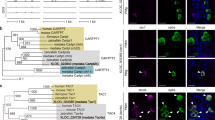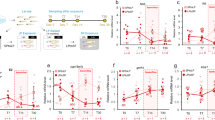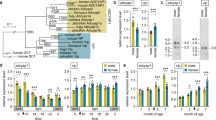Abstract
Understanding of pheromone function in teleost fish has been impeded by a lack of information on pheromone identities1. Our recent studies2,3 on goldfish Carassius auratus, however, provide strong evidence that 17α,20β-dihydroxy-4-pregnen-3-one (17,20P), the proposed oocyte maturation-inducing steroid hormone in goldfish4 and other teleosts5, could be a potent female sex pheromone. Milt (sperm and seminal fluid) volume in goldfish is increased by exposure to 17,20P (and to a lesser extent by exposure to two precursors of 17,20P, progesterone and 17α-hydroxyprogesterone) but not to other steroids proposed as fish pheromones1,6,7. In addition, the goldfish olfactory epithelium is extremely sensitive to 17,20P (ref. 3), and the increase in milt volume normally induced by 17,20P exposure is abolished by sectioning the medial olfactory tracts, which previously have been implicated in the control of sex behaviour in male goldfish8. We report here that ovulating goldfish release 17,20P into the water and that a rapid (within 15 min) elevation in blood gonadotropin of males mediates the milt response to 17,20P exposure. We conclude that this pheromone system synchronizes milt production with ovulation.
This is a preview of subscription content, access via your institution
Access options
Subscribe to this journal
Receive 51 print issues and online access
$199.00 per year
only $3.90 per issue
Buy this article
- Purchase on Springer Link
- Instant access to full article PDF
Prices may be subject to local taxes which are calculated during checkout
Similar content being viewed by others
References
Stacey, N. E., Kyle, A. L. & Liley, N. R. in Chemical Communication in Vertebrates Vol. IV (eds Duvall, D., Muller-Schwarze, D. & Silverstein, R. M.) 117–133 (Plenum, New York, 1986).
Stacey, N. E. & Sorensen, P. W. Can. J. Zool. (in the press).
Sorensen, P. W., Hara, T. J. & Stacey, N. E. J. comp. Physiol. (in the press).
Nagahama, Y. et al. Gen. comp. Endocr. 51, 15–23 (1983).
Goetz, F. W. in Fish Physiology, Vol. IXB (eds Hoar, W. S., Randal, D. J. & Donaldson, E. M.) 117–170 (Academic, New York, 1983).
Colombo, L., Belvedere, P. C., Marconato, A. & Bentivegna, F. in Proc. Int. Symp. Reprod. Physiol. Fish. (eds Richter, C. J. J. & Goos, H. J. Th.) 84–94 (Pudoc, Wageningen, 1982).
Van den Hurk, R. & Lambert, J. G. D. Can. J. Zool. 61, 2381–2387 (1982).
Stacey, N. E. & Kyle A. L. Physiol. Behav. 30, 621–628 (1983).
Stacey, N. E., Cook, A. F. & Peter, R. E. Gen. comp. Endocr. 37, 246–249 (1979).
Stacey, N. E. et al. Can. J. Zool. 61, 2646–2652 (1984).
Kyle, A. L., Stacey, N. E., Peter, R. E. & Billard, R. Gen. comp. Endocr. 57, 10–22 (1985).
Billard, R., Fostier, A., Weil, C. & Breton, B. Can. J. Fish. aquat. Sci. 39, 65–79 (1982).
Ueda, H., Kambegawa, A. & Nagahama, Y. Gen. comp. Endocr. 59, 24–30 (1985).
Kobayashi, M., Aida, K. & Hanyu, I. Gen. comp. Endocr. 62, 70–79 (1986).
Scott, A. P., Sheldrick, E. L. & Flint, A. P. F. Gen. comp. Endocr. 46, 444–451 (1982).
Van Der Kraak, G., Dye, H. M. & Donaldson, E. M. Gen. comp. Endocr. 55, 36–45 (1984).
Yamazaki, F. Mem. Fac. Fish. Hokkaido Univ. 13, 1–65 (1965).
Peter, R. E., Nahorniak, C. S., Chang, J. P. & Crim, L. W. Gen. comp. Endocr. 55, 337–346 (1984).
Author information
Authors and Affiliations
Rights and permissions
About this article
Cite this article
Dulka, J., Stacey, N., Sorensen, P. et al. A steroid sex pheromone synchronizes male–female spawning readiness in goldfish. Nature 325, 251–253 (1987). https://doi.org/10.1038/325251a0
Received:
Accepted:
Issue Date:
DOI: https://doi.org/10.1038/325251a0
This article is cited by
-
Crucian carp (Carassius carassius (L.)), an anonymous fish with great skills
Ichthyological Research (2023)
-
Chemical cues for intraspecific chemical communication and interspecific interactions in aquatic environments: applications for fisheries and aquaculture
Fisheries Science (2022)
-
Imorin: a sexual attractiveness pheromone in female red-bellied newts (Cynops pyrrhogaster)
Scientific Reports (2017)
-
A hormone-related female anti-aphrodisiac signals temporary infertility and causes sexual abstinence to synchronize parental care
Nature Communications (2016)
-
A Sea Lamprey (Petromyzon marinus) Sex Pheromone Mixture Increases Trap Catch Relative to a Single Synthesized Component in Specific Environments
Journal of Chemical Ecology (2015)
Comments
By submitting a comment you agree to abide by our Terms and Community Guidelines. If you find something abusive or that does not comply with our terms or guidelines please flag it as inappropriate.



